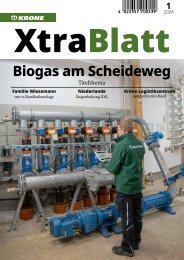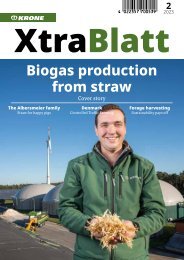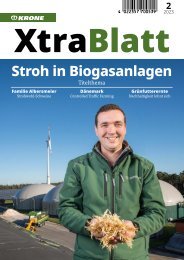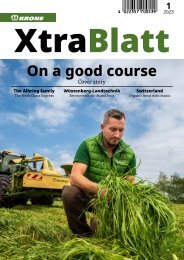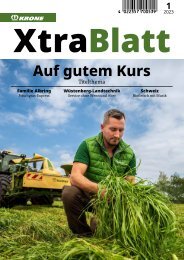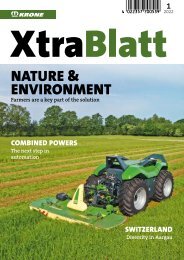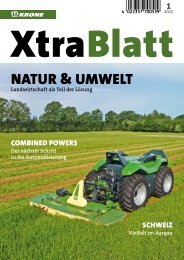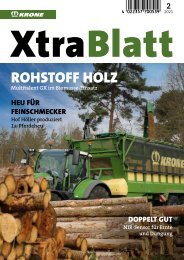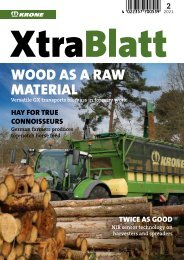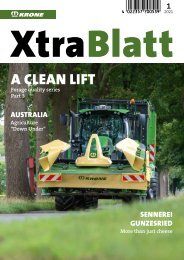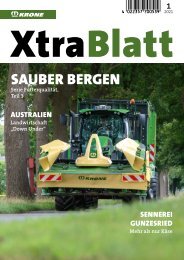XtraBlatt Issue 02-2020
Create successful ePaper yourself
Turn your PDF publications into a flip-book with our unique Google optimized e-Paper software.
INTERNATIONAL<br />
Loading up the bales takes<br />
place without stopping.<br />
Will Murphy contracts two farmers for<br />
collection and stacking of bales. They have to<br />
supply their own machinery.<br />
Stacking the bales eight-high and pressing<br />
them tightly together keeps rain<br />
from seeping in.<br />
WITH MOISTURE METER<br />
The electricity power plant accepts straw at up to 25 %<br />
moisture content (mc), but the contractor stops baling when<br />
this reaches 18 % in the field, giving a safe margin. After all,<br />
the straw is stored out in the open after baling. The HDP<br />
High Speed with the MF managed almost 15,000 bales in<br />
season 2018. Average weight for wheat straw (at 10 % mc)<br />
was 490 kg, representing a baling density at the terminal of<br />
95 %. The HDP II manages bales of 530 kg with a 70 % setting<br />
at the terminal. “The HDP II should manage around 20,000<br />
bales per year”, Will Murphy is sure. In six weeks, the young<br />
entrepreneur estimates a production of over 30,000 bales<br />
from around 4,000 ha.<br />
When there’s baling straw lying ready in the bout, the drivers<br />
leave the depot by 8.30 am and this is often a little early<br />
in the day, the moisture meters on board indicate when<br />
it’s safe to start baling. Will Murphy says of his strategy: “I<br />
would rather that the drivers are already on the spot and<br />
have maybe time for a cup of tea than when they set off<br />
at 10 am and maybe miss an hour of baling before they<br />
eventually get started.”<br />
Will Murphy specialises in<br />
straw baling with his farm<br />
contractor business.<br />
This is also right for the farmers involved. It’s in their interest<br />
when the stubble is cleared as fast as possible. Mostly,<br />
both balers drive to the same field. As a rule, the HDP High<br />
Speed bales the headlands and any irregular border areas.<br />
Then the HDP II goes in set at maximum performance on<br />
the long swaths.<br />
Information on the areas to be baled is sent to the contractor<br />
via Shape file, but also per printed maps from the farm<br />
computer. The data can also be read and managed on smart<br />
phones using the app Harvestyield. In this case, all the driver<br />
needs to do is enter starting and finishing time plus bale<br />
count. This information is the basis for subsequent invoicing.<br />
FAST BALE COLLECTOR<br />
Will Murphy hires a couple of farmers for<br />
bale collection and stacking. Both bring<br />
tractors pulling Heath Super Chaser<br />
QM Extra trailers, specially conceived<br />
for the 120 x 90 cm bales. The drivers<br />
collect bales at a good lick with usually<br />
no stopping. A dozer blade mounted<br />
on the tractor front weights is used<br />
to push each bale in line with trailer<br />
travel direction. Pick-up spikes<br />
in front of the offset trailer lift each bale, placing it on the<br />
trailer floor from where each is hydraulically pushed back.<br />
The sides of the baler load are also continually pushed in by<br />
side-gates, also hydraulically powered. Up to 16 big square<br />
bales make up a load on the chaser trailers. The loads are<br />
then towed to a collection point where the trailer is tipped<br />
to a vertical position and backed against the existing stack<br />
(if already established) before jerking away to leave the load<br />
on the ground. The trailer system apparently makes for very<br />
compact stacking of the bales, offering good protection<br />
against rain seepage.<br />
STRAW STACKS<br />
The stack stacks built by the chaser trailers have a maximum<br />
height of eight bales with, once again, very tight packing.<br />
Moisture must be kept out this way because no rain covers<br />
are used. The straw collecting team is hired directly by Will<br />
Murphy, the two farmers having to supply their own kit:<br />
the bale collection trailers being leased by them for the<br />
season. Subsequent road travel to the biofuel power plants<br />
is then by truck.<br />
A truck load is usually 54 120 x 90 cm bales which means<br />
a height of just over 5m. The season for road transport<br />
is usually from harvest through to Christmas time and<br />
this easier timetable reduces stress for the truck loading,<br />
which takes place with two telescope loaders owned by Will<br />
Murphy. Lift capacity is 3 t and reach 9.50 m.<br />
During our visit it had rained heavily in the previous night,<br />
which meant a start couldn’t be made to the planned<br />
barley straw baling. However, the oilseed rape straw was<br />
dry enough to get started on. One aspect that gave the<br />
visitor something to ponder over was the possible longerterm<br />
effects of baling and completely removing virtually all<br />
organic material left on the combined fields.<br />
Otherwise, the enterprise certainly seems to represent a<br />
good business model for everyone concerned. For instance,<br />
the combines don’t need to chop the straw, which makes<br />
for an easier threshing job and less power requirement.<br />
The cereal growing farmer has no lying straw to cope with.<br />
The material is quickly baled and removed. On average,<br />
our contractor this year was paying the farmer 15–20 GBP<br />
(17–22 €) per tonne straw baled and carted off the field. The<br />
contractor calculated his costs right up to delivery to the<br />
power plant at 36–42 GBP/t (40–46 €). This takes account<br />
of all inputs: baling twine, collection, further transport.<br />
The costs Will Murphy calculated for the baling seemed<br />
extremely low. What the contractor actually received for his<br />
straw on delivery at the power plant, he did not wish to read<br />
about in this magazine. But in the light of the high work rate<br />
and the low costs this appears to be a profitable business.<br />
The principle of investing in optimal baling technology<br />
and protecting it through extra warranty seems to pay off<br />
here. Maintenance is carried out by the local dealership.<br />
The young contractor reports he’s experienced no serious<br />
problems with the Krone balers. «<br />
30 31 31




